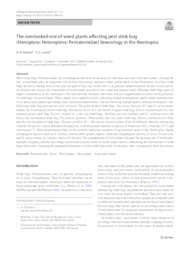The overlooked role of weed plants afecting pest stink bug (Hemiptera: Heteroptera: Pentatomidae) bioecology in the Neotropics.
The overlooked role of weed plants afecting pest stink bug (Hemiptera: Heteroptera: Pentatomidae) bioecology in the Neotropics.
Author(s): PANIZZI, A. R.; LUCINI, T.
Summary: Abstract: Most stink bugs (Pentatomidae) are polyphagous and feed on an array of cultivated and non-cultivated plants. Among the last, weed plants play an important role in their bioecology and pest status, particularly in the Neotropics, in where stink bugs are active during most of the year. In spite of this, the weeds role is, in general, underestimated. In this review article we present and discuss the importance of weed plants present in row crops and pasture lands, afecting stink bugs pests of major commodities in the Neotropics. We surveyed the literature and other sources (unpublished records) on the presence of stink bugs on weed plants. These plants were ranked as hosts (allowing nymph development and/or adult reproduction) or as associated plants (providing some nutrients/water/shelter, but not allowing nymph and/or adult performance). The following stink bug pest species were covered: The green-bellied stink bugs, Diceraeus furcatus (F.) and D. melacanthus Dallas; the Neotropical brown sink bug, Euschistus heros (F.); the brown-winged stink bug, Edessa meditabunda (F.); the southern green stink bug, Nezara viridula (L.); the rice stink bugs, Oebalus poecilus (Dallas) and O. ypsilongriseus (De Geer); the red-banded stink bug, Piezodorus guildinii (Westwood); the rice stalk stink bug, Tibraca limbativentris Stål; and the red-shouldered stink bug, Thyanta perditor (F.). The survey showed plants from 16 diferent families interacting with the 10 species of pest pentatomids analyzed, with the greater number of species of Fabaceae (16+), Poaceae (14+), and Asteraceae (7). Data demonstrated that, in the modern landscape scenario of agricultural areas in the Neotropics, highly polyphagous species, such as N. viridula, tend to sufer greater impact, while the oligophagous species, E. heros, D. furcatus, and D. melacanthus, in contrast, tend to be favored. The management of weed plants through the increase use of herbicides, multiple cropping, and the non-tillage cultivation systems seems to be the major factors infuencing the interactions of stink bugs and weeds, changing the population dynamics of pest stink bugs in the Neotropics, and, consequently their pest status.
Publication year: 2022
Types of publication: Journal article
Unit: Embrapa Wheat
Observation
Some of Embrapa's publications are published as ePub files. To read them, use or download one of the following free software options to your computer or mobile device. Android: Google Play Books; IOS: iBooks; Windows and Linux: Calibre.
Access other publications
Access the Agricultural Research Database (BDPA) to consult Embrapa's full library collection and records.
Visit Embrapa Bookstore to purchase books and other publications sold by Embrapa.

